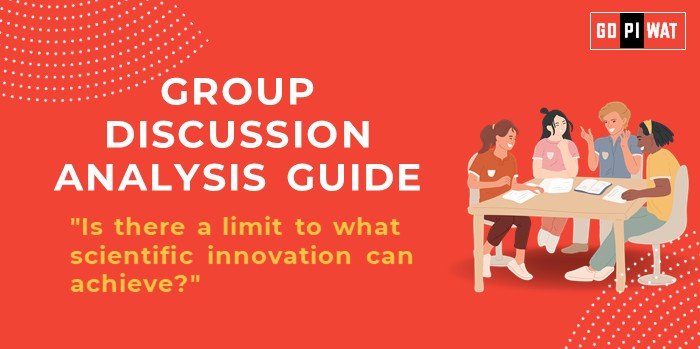📋 Group Discussion (GD) Analysis Guide
🌐 Introduction: “Is there a limit to what scientific innovation can achieve?”
- Opening Context: Scientific innovation has continually transformed human existence, from harnessing fire to exploring the depths of space. Yet, debates about its limits remain vital, considering ethical dilemmas, resource constraints, and the laws of nature.
- Topic Background: The rapid pace of scientific progress often raises the question of whether it will hit natural, ethical, or social boundaries. Advances like CRISPR in genetics, artificial intelligence, and quantum computing push the boundaries of what we previously deemed impossible, making this a topic of profound relevance for B-school students who will lead industries shaped by these innovations.
📊 Quick Facts and Key Statistics
- 🧬 Human Genome Project Completion (2003): Deciphered 3 billion DNA base pairs—significant for medical and genetic research.
- 🤖 Artificial Intelligence Market Size: Expected to grow from $142 billion in 2023 to $1.81 trillion by 2030 (Statista, 2024).
- 🔬 Global R&D Spending: $2.47 trillion in 2023, led by countries like the U.S. and China (UNESCO).
- 🌱 Energy Constraints: Current global renewable energy share—30%, highlighting sustainability challenges.
👥 Stakeholders and Their Roles
- 🏛️ Governments: Funding, ethical oversight, and regulation.
- 🏢 Private Sector: Driving innovation through investments and market applications.
- 🎓 Academia and Research Institutions: Fundamental research and breakthroughs.
- 🧑🤝🧑 Citizens: Societal acceptance and ethical debates.
- 🌍 International Organizations: Collaborations for global challenges like climate change and pandemics.
🏆 Achievements and Challenges
✨ Achievements:
- 💉 Development of mRNA vaccines in record time during the COVID-19 pandemic.
- 🧬 CRISPR technology revolutionizing genetic engineering.
- 💻 Breakthroughs in quantum computing by Google and IBM.
⚠️ Challenges:
- 🧠 Ethical dilemmas in AI and genetic modification.
- ⛏️ Resource limitations like rare earth metals for electronics.
- 🌍 Environmental concerns from industrial and technological waste.
🌍 Global Comparisons:
- ✅ Success: Estonia’s e-governance systems lead in cybersecurity and digital services.
- ⚔️ Challenges: The U.S.-China tech rivalry highlights limits of geopolitics in innovation.
📖 Case Studies:
- 🚀 India’s Chandrayaan missions demonstrating cost-effective space exploration.
📄 Structured Arguments for Discussion
- Supporting Stance: “Scientific innovation has consistently overcome barriers, unlocking possibilities previously unimaginable, from moon landings to AI-powered healthcare.”
- Opposing Stance: “Innovation faces insurmountable limits due to physical laws, resource constraints, and ethical boundaries, such as in cloning or AI.”
- Balanced Perspective: “While innovation pushes boundaries, natural laws and societal norms dictate its trajectory, necessitating a balanced approach.”
💡 Effective Discussion Approaches
- Opening Approaches:
- “As technology accelerates, we must ask: Are we reaching the edge of innovation’s potential or just beginning?”
- “From the wheel to AI, science has redefined limits, but does it defy them entirely?”
- Counter-Argument Handling:
- Example: “Acknowledging finite resources, can breakthroughs in renewable energy offset limitations in fossil fuels?”
🔍 Strategic Analysis of Strengths and Weaknesses
- Strengths:
- Expanding AI and biotechnology applications.
- Global collaborations like CERN and ISS.
- Weaknesses:
- Dependence on finite resources.
- Unequal access to advancements.
- Opportunities:
- Space exploration and colonization.
- Green technology development.
- Threats:
- Ethical misuse and geopolitical conflicts.
📚 Connecting with B-School Applications
- Real-World Applications:
- Innovations like AI impact supply chain management, finance, and marketing.
- Sample Interview Questions:
- “How can ethics shape the future of AI and biotechnology?”
- “What role can businesses play in fostering sustainable innovation?”
- Insights for B-School Students:
- Leadership requires integrating innovation with ethical responsibility.
- Understanding disruptive technologies is essential for strategic decision-making.


